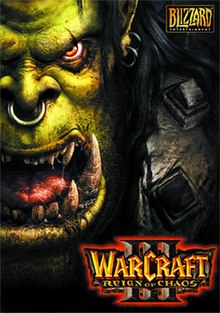
Back Warcraft III: Reign of Chaos Afrikaans وور كرافت 3: عهد الفوضى Arabic وواركرافت 3 ARZ Warcraft III: Reign of Chaos AST Warcraft III: Reign of Chaos Byelorussian Warcraft III: Reign of Chaos Bulgarian Warcraft III: Reign of Chaos Catalan Warcraft III: Reign of Chaos Czech Warcraft III: Reign of Chaos Danish Warcraft III: Reign of Chaos German
| Warcraft III: Reign of Chaos | |
|---|---|
 Warcraft III Orc box art | |
| Developer(s) | Blizzard Entertainment |
| Publisher(s) | Blizzard Entertainment[a] |
| Director(s) | Frank Pearce Jr. |
| Producer(s) | Chris Sigaty |
| Designer(s) | Rob Pardo |
| Artist(s) | Samwise Didier |
| Writer(s) | Chris Metzen |
| Composer(s) |
|
| Series | Warcraft |
| Platform(s) | Microsoft Windows, Classic Mac OS, Mac OS X |
| Release | |
| Genre(s) | Real-time strategy |
| Mode(s) | Single-player, multiplayer |
Warcraft III: Reign of Chaos is a high fantasy real-time strategy computer video game developed and published by Blizzard Entertainment released in July 2002. It is the second sequel to Warcraft: Orcs & Humans, after Warcraft II: Tides of Darkness, the third game set in the Warcraft fictional universe, and the first to be rendered in three dimensions. An expansion pack, The Frozen Throne, was released in July 2003. Warcraft III is set several years after the events of Warcraft II, and tells the story of the Burning Legion's attempt to conquer the fictional world of Azeroth with the help of an army of the Undead known as the Scourge, led by fallen paladin Arthas Menethil. It chronicles the combined efforts of the Human Alliance, Orcish Horde, and Night Elves to stop them before they can corrupt the World Tree.
In the game, as in many real-time strategy (RTS) games, players collect resources, train individual units and heroes, and build bases in order to achieve various goals (in single-player mode), or to defeat the enemy player. Four playable factions can be chosen from: Humans, Orcs, (both of which appeared in the previous games) and two new factions: the Night Elves and the Undead. Warcraft III's single-player campaign is laid out similarly to that of StarCraft, and is told through the races in a progressive manner. Players can also play matches against the computer, or against others—using local area networking (LAN) or Blizzard's Battle.net gaming platform.
After Warcraft II: Beyond the Dark Portal, the last in the Warcraft saga, was released in 1996, Blizzard began development of a point-and-click adventure game called Warcraft Adventures: Lord of the Clans, which was supposed to continue the story. Lord of the Clans was canceled in favor of Warcraft III in 1998, which was presented to the public at the European Computer Trade Show in September 1999. The game's design and gameplay was significantly altered during development, with the final game sharing little similarities with the originally presented version (see similarities to StarCraft).
The game received acclaim from critics, who praised the game's presentation and multiplayer features. It is considered an influential example of RTS video games and one of the greatest video games ever made. Warcraft III was a commercial success, shipping 4.4 million copies to retail stores,[2] selling over a million within a month. Video game modifications created with the World Editor, such as Defence of the Ancients, led to lasting changes and inspired many future games. In 2020, Blizzard released a remastered version of both Warcraft III and its expansion, The Frozen Throne, called Warcraft III: Reforged.
- ^ https://dengekionline.com/data/news/2003/1/20/63f8acd76ecb9ca606073ddbea35952e.html
- ^ Bramwell, Tom (January 5, 2004). "WarCraft III tops 1m sales in Europe". Eurogamer. Retrieved July 5, 2021.
Cite error: There are <ref group=lower-alpha> tags or {{efn}} templates on this page, but the references will not show without a {{reflist|group=lower-alpha}} template or {{notelist}} template (see the help page).